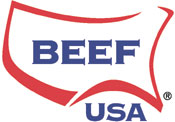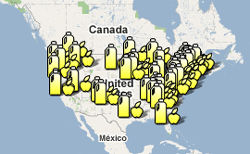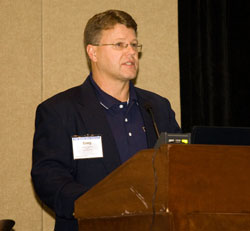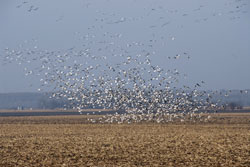I just had to write about this since I’ve been doing more and more consulting on the use of new media and social networking for agribusiness. It is the idea of “community” instead of an “audience.” In most of my presentations I try to work in this concept since I think it’s at the root of what’s driving the success of online networking whether it’s MySpace, Facebook, Flickr, YouTube, blogging or podcasting. You are part of the AgWired community. We’re in this together and this blog allows us to interact. You may not see or read all the comments that get posted but they’re a small part of the feeback I get from emails, phone calls and face to face conversation. I’m really not trying to force what I think is important on you (usually) but post information that you think is important to the community. That’s why I ask questions and seek your thoughts and suggestions all the time. Do you agree?
The age of instantaneous internet communications via computer, mobile phone, iPod or whatever is your gadget of choice, is here to stay. Farmers are engaged and there’s no going back. There’s increasing evidence of this everywhere you turn, including at whatever farm show you happened to attend this winter. However, there are still a lot of people involved in agrimarketing and communications who just don’t get it or maybe they’re just hoping that they can hang on to “the way it’s always been done” until they retire.
I’ve been hearing a lot about a new book titled, “Here Comes Everybody: The Power of Organizing Without Organizations” by Clay Shirky. I’ve got a copy on order. I found the following excerpt on this idea of community vs. audience from “Teaching Online Journalism.” I think Clay’s made an excellent point and wonder what you think about it. By the way, new media teaching is really catching on in our J-schools as evidenced by this excellent blog.
A good deal of user-generated content isn’t actually “content” at all, at least not in the sense of material designed for an audience. Instead, a lot of it is just part of a conversation.
Mainstream media has often missed this, because they are used to thinking of any group of people as an audience. Audience, though, is just one pattern a group can exist in; another is community. Most amateur media unfolds in a community setting, and a community isn’t just a small audience; it has a social density, a pattern of users talking to one another, that audiences lack. An audience isn’t just a big community either; it’s more anonymous, with many fewer ties between users. Now, though, the technological distinction between media made for an audience and media made for a community is evaporating; instead of having one kind of media come in through the TV and another kind come in through the phone, it all comes in over the internet.
As a result, some tools support both publication and conversation. Weblogs aren’t only like newspapers and they aren’t only like coffeeshops and they aren’t only like diaries — their meaning changes depending on how they are used, running the gamut from reaching the world to gossiping with your friends.
I also think of communities as being somewhat small and where people share common interests. I think that’s another reason the traditional marketers and communicators are having problems with blogs and podcasts. They try to measure their success in the same way they measure a mass media buy. How many impressions did I make? Of course you don’t really know the answer to that question since you don’t know if they were really listening, watching or reading. I’d much rather reach a small audience of actively engaged participants than waste a lot of money reaching a larger “audience” of people who aren’t really paying attention and may not even be interested in what I have to sell. I think people who subscribe to or regularly read a blog are much more likely to support the companies that are supporting the “community” and more likely to pass that enthusiasm along to others.
These are people like you who are choosing to be here and/or subscribe. You are the AgWired We.
 Just like last year, the Plant Pathology Journalism Award excludes websites, which might exclude some quality entries. I’m not a plant pathologist so maybe there’s no one writing on the web about this subject? I guess they only consider you a journalist if you’re printed or broadcast. Applications are due by April 15 for work in 2007.
Just like last year, the Plant Pathology Journalism Award excludes websites, which might exclude some quality entries. I’m not a plant pathologist so maybe there’s no one writing on the web about this subject? I guess they only consider you a journalist if you’re printed or broadcast. Applications are due by April 15 for work in 2007.

 Here’s a little update on that
Here’s a little update on that  I’m not sure who created and manages the Power Guides but since they commented here I thought I’d point them out. It’s one of those anonymous things which I really don’t like although I can see that there is someone named Steve who posted
I’m not sure who created and manages the Power Guides but since they commented here I thought I’d point them out. It’s one of those anonymous things which I really don’t like although I can see that there is someone named Steve who posted  The CW Network will replay last week’s episode of
The CW Network will replay last week’s episode of  I hope you’re getting ready to wear the green for St. Patrick’s Day. While you’re at it you can’t go wrong with a
I hope you’re getting ready to wear the green for St. Patrick’s Day. While you’re at it you can’t go wrong with a  BASF Senior Technical Service Representative Greg Stapleton has just been awarded the Distinguished Service Award for Industry at the
BASF Senior Technical Service Representative Greg Stapleton has just been awarded the Distinguished Service Award for Industry at the  I think it must be getting near spring time if the Sandhill Cranes are flying over Nebraska. Here’s a formation doing a flyover when I gassed up on my way back from Omaha today.
I think it must be getting near spring time if the Sandhill Cranes are flying over Nebraska. Here’s a formation doing a flyover when I gassed up on my way back from Omaha today. The common name of this bird references habitat like that at the Platte River, on the edge of Nebraska’s Sandhills in the American midwest. This is the most important stopover area for the Lesser Sandhill Crane, Grus (canadensis) canadensis, with up to 450,000 of these birds migrating through annually.
The common name of this bird references habitat like that at the Platte River, on the edge of Nebraska’s Sandhills in the American midwest. This is the most important stopover area for the Lesser Sandhill Crane, Grus (canadensis) canadensis, with up to 450,000 of these birds migrating through annually.